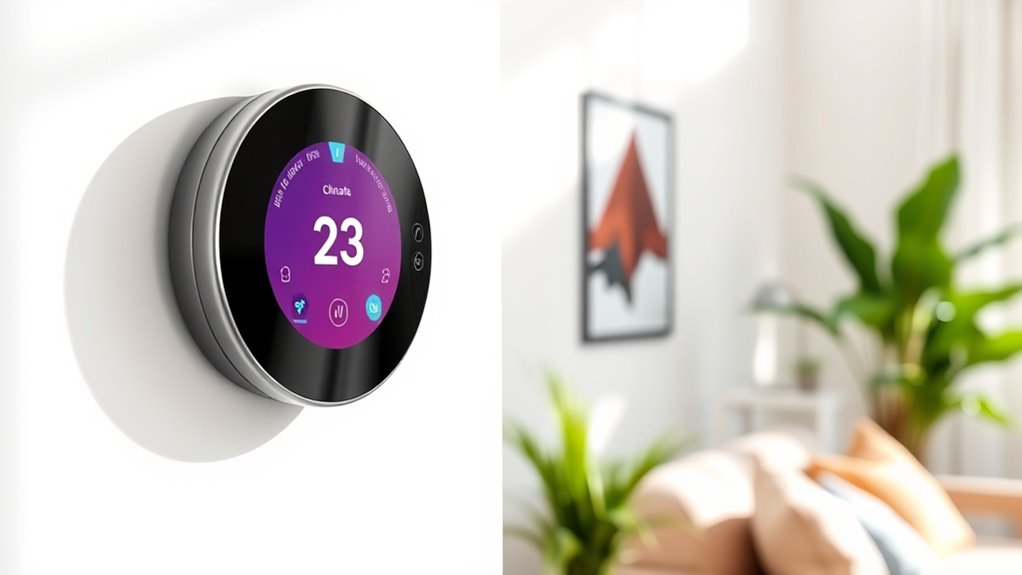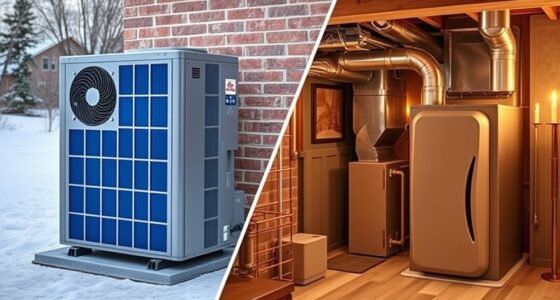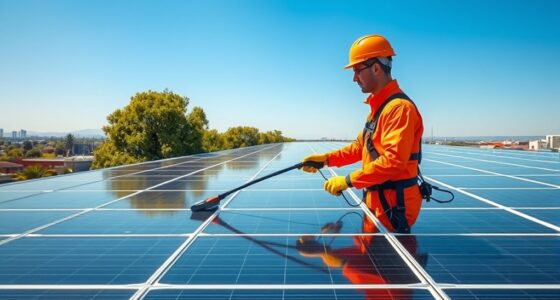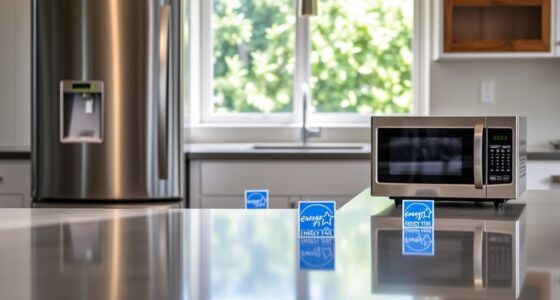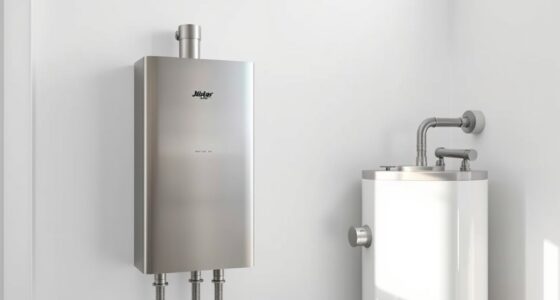Using a smart thermostat can help you cut energy bills by automatically adjusting your home’s temperature based on your schedule and occupancy. These devices learn your habits, optimize heating and cooling, and even let you control settings remotely via smartphone. This leads to savings of 10-20% annually, with typical reductions of $130-$145 a year. If you want to discover the best ways to maximize your savings, there’s more to explore below.
Key Takeaways
- Smart thermostats can save 10% to 20% annually on heating and cooling costs through optimized scheduling.
- Using occupancy sensors and learning features automatically adjusts temperature settings when rooms are unoccupied.
- Remote control via Wi-Fi allows users to fine-tune settings and monitor energy use from anywhere.
- Integrating smart thermostats with other smart home devices enhances overall energy efficiency.
- Utility incentives and long-term savings make investing in smart thermostats a cost-effective way to reduce bills.
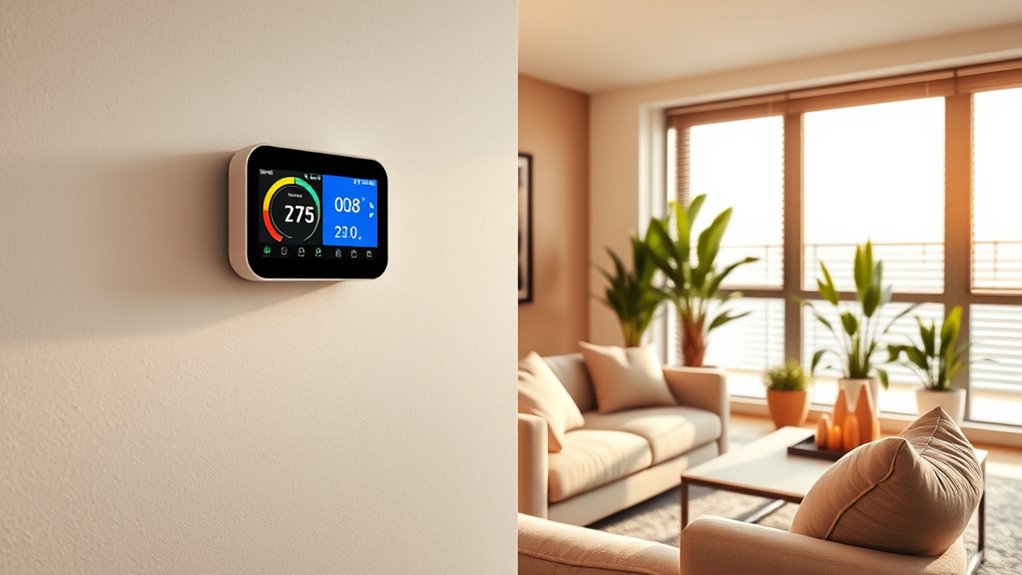
Smart thermostats have become a savvy choice for homeowners looking to cut energy bills and reduce environmental impact. They can save you between 10% and 20% annually on heating and cooling costs, which adds up over time. These devices use advanced algorithms and sensors to optimize your home’s energy use, guaranteeing that you’re not wasting resources when you’re not home or when the house doesn’t need to be as warm or cool. By adjusting your thermostat by just 7 to 10 degrees for about eight hours each day, you can see savings of up to 10% on your energy bills, making a noticeable difference in your monthly expenses.
Smart thermostats help homeowners save up to 10% on energy bills by optimizing temperature settings when you’re away or asleep.
The market for smart thermostats is expanding rapidly, driven by increased awareness of energy efficiency and the integration of smart home technology. Different types are available to suit your needs, including connected models that interface via Wi-Fi or Bluetooth, and learning thermostats that adapt to your habits over time. Standalone options are also available, which operate independently but may lack some features. Voice-activated models are growing in popularity, allowing you to control your thermostat hands-free, while occupancy sensing technology ensures the device automatically adjusts based on whether a room is occupied. These features work together to enhance comfort while reducing unnecessary energy consumption.
For you as a homeowner, the benefits extend beyond savings. Smart thermostats can automatically adjust temperatures based on your schedule and occupancy patterns, freeing you from constantly fiddling with the settings. They also provide detailed insights into your energy consumption, helping you understand when and how you’re using energy most. Many utility companies encourage adoption by offering incentives, which can offset the initial cost of $100 to $300. Over time, the savings on your energy bill—typically around $131 to $145 annually—more than make up for this investment, especially if you plan to stay in your home long term.
Integrating your smart thermostat with other home systems maximizes its benefits. It can communicate seamlessly with other smart devices, support renewable energy sources, and even leverage AI and machine learning to improve efficiency. Interconnectivity allows you to create a holistic energy management system, enhancing both comfort and savings. Some models also include health-focused features, ensuring your indoor environment remains comfortable and safe.
Additionally, advancements in AI Security technologies are making smart thermostats more secure against cyber threats, protecting your home network from potential breaches. Switching to a smart thermostat is a cost-effective move that pays off over time. The initial investment is small compared to the long-term savings and environmental benefits. As the market continues to grow, so do the incentives and technological innovations, making it easier than ever for you to reduce your carbon footprint and lower your energy bills. With smart thermostats, you’re not just saving money—you’re also contributing to a more sustainable future.
Frequently Asked Questions
How Do Smart Thermostats Integrate With Existing Home Automation Systems?
Smart thermostats easily integrate with your existing home automation systems by connecting through Wi-Fi and compatible platforms like Amazon Alexa, Google Home, or Apple HomeKit. You can control the temperature via voice commands or apps, and they work seamlessly with smart lights, shades, and security systems. Just make sure your HVAC is compatible, and consider professional installation for ideal setup, calibration, and integration with other devices for a fully automated, energy-efficient home.
Are There Any Privacy Concerns With Smart Thermostat Data Collection?
You should be aware that smart thermostats collect data on your temperature preferences, habits, and usage. While this helps optimize your comfort and energy use, it raises privacy concerns, like potential data breaches or unauthorized access. Manufacturers often share data with third parties, and many users aren’t fully aware of how their info is used. To protect yourself, use secure Wi-Fi, enable multi-factor authentication, and stay informed about data policies.
Can Smart Thermostats Be Used Effectively in Multi-Zone Homes?
You can definitely use smart thermostats effectively in multi-zone homes. They allow you to control different areas separately, so you only heat or cool occupied spaces. With features like remote control, automation, and sensors, you can customize temperatures for each zone, saving energy and money. These systems are compatible with various HVAC setups and improve comfort by preventing conflicts over temperature settings.
What Is the Typical Learning Curve for New Users?
You’ll find that the typical learning curve for new users takes a few weeks, depending on your familiarity with technology and the device’s complexity. During this time, you’ll adjust settings, explore features like geofencing, and get comfortable with the interface. Customer support can help shorten this period, ensuring you understand how to optimize the thermostat. With patience, you’ll become adept at using it to maximize comfort and savings.
Do Smart Thermostats Require Professional Installation or Can I Install Them Myself?
You’re wondering if you can install a smart thermostat yourself or need professional help. It depends on your HVAC system’s complexity and wiring. If your system is simple, has a C-wire, and you’re comfortable with basic electrical work, DIY installation is possible—just follow the manufacturer’s instructions. However, for multi-stage, complex systems, or if you lack a C-wire, hiring a professional guarantees a safe, proper setup and avoids potential damage.
Conclusion
By installing a smart thermostat, you can effortlessly cut your energy bills. For example, imagine setting your thermostat to lower the temperature overnight; your device learns your schedule and adjusts accordingly. Over time, this means savings without sacrificing comfort. With smart thermostats, you take control of your energy use, making small changes that add up. So, why not give it a try and enjoy lower bills while staying cozy all year round?

